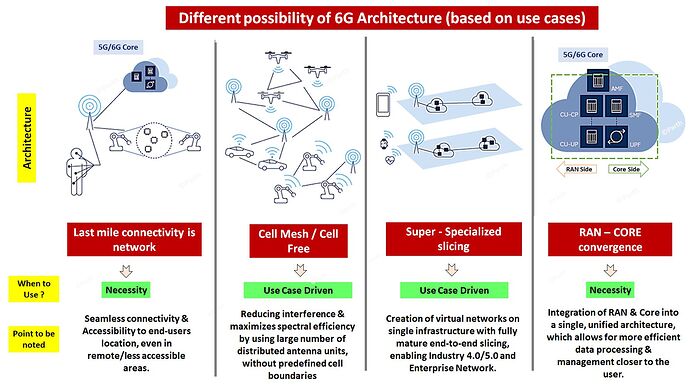Different possibility of 6G Architecture
India ![]() improved its mobile broadband speed from 118th to 39th globally via 5G, fiber, and digitization. With the advent of 6G deployment by 2026, and eye to secure spot in top 5 globally. Below are different possibility of 6G Architecture based on use cases & needs.
improved its mobile broadband speed from 118th to 39th globally via 5G, fiber, and digitization. With the advent of 6G deployment by 2026, and eye to secure spot in top 5 globally. Below are different possibility of 6G Architecture based on use cases & needs.
1) Last Mile Connectivity is Network
To provide services/network that connects the service provider’s infrastructure to end-users location, even in remote / less accessible areas.
Why it is Different from 4G/5G ? - 4G/5G primarily aim was to provide speed & capacity, 6G aim is to provide ubiquitous connectivity.
2) Cell Mesh / Cell Free
It eliminates traditional cell boundaries by involving large number of distributed antenna units that together serve users without predefined cell boundaries, which helps in reducing interference & maximizes spectral efficiency.
Why it is Different from 4G/5G ? - In 4G we had traditional cell towers, In 5G we introduces Pico | Small | Light cells for better coverage and both 4G & 5G had cell boundaries, but in 6G with cell-free architecture it provide seamless connectivity with ultra-low latency & high reliability, especially in dense urban areas and high-mobility scenarios with reduce over-head traffic & interference.
3) Super - Specialized Slicing
Creation of multiple virtual networks on single physical infrastructure with fully mature end-to-end slicing, later optimizing it for specific use cases to enable Industry 4.0/5.0 and Enterprise Network use cases.
Why it is Different from 4G/5G ? - 4G = “No” slicing capabilities, In 5G we have limited slicing capabilities, but in 6G we will have fully matured slicing, which will offer more granular & efficient resource allocation to support wider range of use cases.
4) RAN – CORE Convergence
Integration of RAN & Core into a single, unified architecture, which allows for more efficient data processing & management closer to the user.
Why it is Different from 4G/5G ? - In 4G & early 5G - RAN & Core functions were separate. In 5.5G they integrated them closer and for 6G we have tighter integration of RAN and Core functions to reduce latency, enhance data processing capabilities, & support real-time applications.
Image 1 => Different possibility of 6G Architecture
Image 2 => Comprehensive summary along with Need / Usecase / Benefits mentioned.
To read more and understand each Architecture in details → Visit and read about Different possibility of 6G Architecture
.
.
.
.
.
